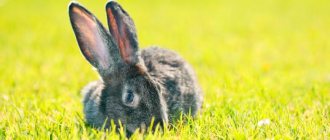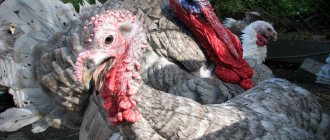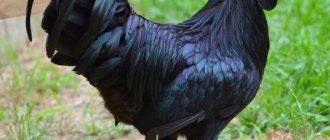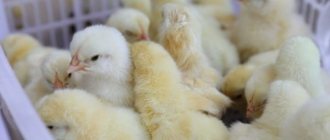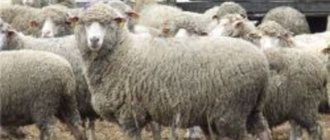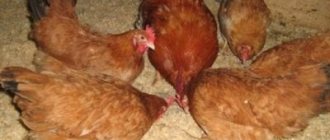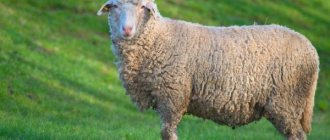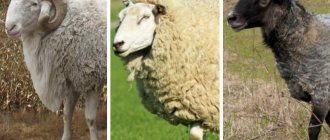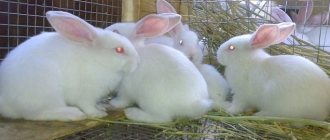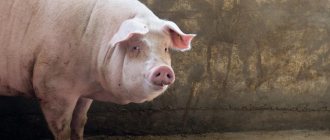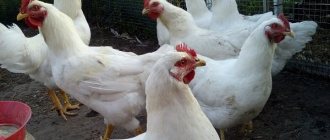The Caucasian and North Caucasian sheep breeds were bred in the Stavropol Territory. Now these animals are bred mainly in the south of Russia or in neighboring countries with a similar climate. Breeding sheep of these breeds is a profitable undertaking due to their high productivity in both meat and wool.
Caucasian breed of sheep
Caucasian breed of sheep
The meat, wool and milk production of sheep occupies a primary place when choosing the breed of these animals.
Most farmers raise sheep solely for the purpose of producing meat and wool. The best breed in this regard is considered to be the Caucasian one. Caucasian sheep were bred on the territory of the former Soviet Union in the Stavropol Territory on the basis of a breeding plant. The approximate years of creation of the breed are 1924-1936; work on the breed was entrusted to local livestock specialists and breeders Ya. V. Sladkevich and K. D. Filyansky. The new breeding breed was developed by reproductively crossing American Ramboulier rams with the Ascanian fine-fleece breed. After obtaining high-quality offspring from the first cross, the sheep were crossed again, this time with New Caucasian Merino sheep. The newborn lambs were selected and the crossbreeding experiment continued, this time within a new breed, in order to consolidate the distinctive qualities that had emerged.
The developed breed is characterized by the following special properties:
— high rates of meat and wool yield;
— the constitution of the body is strong;
— the body size of the sheep is average;
- the fleece is strong, dense, closed;
- the neck is thick, gathered in several folds;
- coat color is gray, sometimes brown. Wool covers almost the entire sheep, its length depends on the sex of the animal - for rams - at least 8 centimeters, for queens - 7 centimeters.
The Caucasian breed of sheep is inferior in weight to many others, but in terms of the quality of meat and wool shearing, it more than pays for the costs of purchasing and raising individuals. An adult female reaches a weight of 60 kilograms, a ram with good fattening weighs just over 100 kilograms, with the possible production of wool in quantities from 5 to 9 kilograms, while from one female it is possible to shear no more than 3 kilograms of wool. The wool yield reaches 50%.
This breed is extremely prolific; in particularly successful years, farmers were able to obtain up to 160% yield of young animals, with the usual yield exceeding 140%. Nursing queens produce from 100 kilograms of milk, the lactation period lasts from 60 to 77 days. The fat content of milk is quite high, in some cases it reaches 8%.
The breeding properties of sheep are almost completely transmitted to their offspring; newborn lambs, when crossed with other breeds, have the advantageous qualities characteristic of the Caucasian breed, due to which this breed is used to significantly improve other breeds.
Negative qualities of the breed include sparse hair and insufficient hair in the belly and head. Such shortcomings manifest themselves exclusively on farms where sheep do not have sufficient space for free walking and gathering pasture. The lack of vitamins and supplements also negatively affects the quantity and quality of the coat, it becomes sparse and does not grow long enough for this breed.
Recently, Caucasian sheep have begun to be bred not only in Russia, but also abroad, since the breed is extremely unpretentious to living conditions and is quite capable of being without water for some time; moreover, the sheep interbreed well and produce healthy offspring. Caucasian sheep feel great in large herds, the queens treat the lambs well, cases of queens abandoning their offspring, refusing to give milk and feeding are practically excluded. Sheep have a calm and docile character, they are easy to care for, and there are no signs of aggression even from rams.
In Russia, the breed has become widespread in the North Caucasus, the Middle Volga region, the Urals, Siberia, Kyrgyzstan and Kazakhstan.
Business plan for sheep breeding: accounting for expenses and income
For example, you can take an average farm with a herd of 500 sheep:
- For such a livestock you need 25 hectares of land, which will be divided into plots and sown with grass throughout the spring-summer season;
- The price for renting land in the middle zone is from 100,000 rubles per month;
- Purchase of livestock – from 100,00,000 rubles (from 5,000 rubles for a purebred sheep);
- Feed in winter - from 180,000 rubles.
In the income column, the main item will be the sale of meat. The price per kilogram starts from 100 rubles. From selling the meat of 100 sheep you can earn up to 1,000,000 rubles. Thus, the profitability of the business will be 25%. The farm will reach self-sufficiency after 2 years of operation.
The following will help increase profitability:
- increasing the number of animals to 1000 or more;
- shifting the slaughter schedule closer to the beginning of spring, when the cost of meat increases significantly;
- meat processing (stew or sausage production workshop, smokehouse);
- sale of sheep milk and products made from it (primarily cheese);
- sale of hides and wool to wholesale suppliers. The profit will be small, but stable and will not require additional financial investments;
- sale of breeding young animals.
Sheep breeding as a business: features of product sales
Most often, lamb is sold on the market, trading it personally or with the help of hired sellers. It is not profitable to hand over meat for processing. Meat processing plants prefer to work with large farms, and the wholesale price of meat is significantly lower than the market price.
A promising option is working with restaurants. High-quality mutton and lamb are in great demand, so long-term contracts can be concluded. An equally convenient client is the owner of a small meat processing shop, who relies on expensive and high-quality products.
An approximate business plan for breeding geese at home and step-by-step instructions for creating your own goose farm are in this article.
Master meat processing yourself. Lamb can be smoked, stewed meat, sausages, and snack sets can be prepared from it. Processed meat lasts longer, and its price increases significantly. You can sell products via the Internet, private stores or markets.
Caucasian and North Caucasian sheep
The Caucasian and North Caucasian sheep breeds were bred in the Stavropol Territory. Now these animals are bred mainly in the south of Russia or in neighboring countries with a similar climate. Breeding sheep of these breeds is a profitable undertaking due to their high productivity in both meat and wool.
Caucasian breed of sheep
Maintenance and care
During the hot summer period, in grazing areas it is necessary to provide animals with a resting place and access to fresh, clean water. In winter, insulated rooms without drafts are suitable for keeping sheep. On frosty days, the temperature in the sheepfold should not fall below 12-14 °C. Wooden panels are used to form individual pens.
A prerequisite is the presence of a hard floor (on a soft surface, animals may experience problems with ligaments). The best option is to cover the concrete floor with plank flooring. To make it easier to maintain cleanliness, the floor is laid with a slight slope to allow natural waste drainage.
Caucasian breed of sheep
Caucasian sheep were bred through selective breeding in the Ipatovsky district of the Stavropol Territory. The work on their creation was carried out by breeders at two state farms at once - “Ipatovsky” and “Bolshevik”, and it began in 1924.
Three breeds of sheep with excellent characteristics were taken as a basis:
- American ramboulier;
- merino novocaucasian;
- Ascanian.
From their ancestors, the animals inherited good hair growth, evenness of fleece, as well as a dense physique and height.
Description
Caucasian sheep are quite large: adult rams weigh about 100-115 kg, and ewes weigh 55-65 kg. They have the following characteristics:
- the body is proportional, the constitution is strong;
- the head is small, erect;
- the sheep are polled, the rams have horns;
- the body is elongated, the muscles are well developed;
- the neck is strong, folded;
- the back line is straight;
- the sacrum is wide;
- legs are sinewy and strong;
- the wool is thick, long (7-10 cm), closed-type fleece;
- the hairiness of the head, belly and legs is good;
- cream-colored grease.
Productivity
Sheep of the Caucasian breed produce high quality wool, meat and milk. The average annual wool harvest from a sheep reaches 9 kg. It is possible to remove less wool from the queens - 3.5 kg, but it is assigned a quality level of 64, while the fleece taken from males is given a quality level of 58-60.
Zoological classification
The zoological classification of rams is based on the length and shape of the tail. This is a conditional systematization of animals belonging to different subgroups. It is also called morphological.
Classification according to zoological principle:
- short-tailed with a skinny tail (northern, Romanovskaya);
- long-tailed with a skinny tail (fine-fleece and semi-fine-fleece breeds);
- short-tailed with fatty deposits in the tail area (Telenginskaya, Buryatskaya, Kulundinskaya);
- long-tailed with fatty deposits in the tail area (Kuchugurovskaya, Georgian, Karakul);
- fat-tailed breeds with a short, underdeveloped tail (Asian fat-tailed breeds).
North Caucasian breed of sheep
Breeders from the Stavropol Territory also worked on the creation of this breed. The work began during the Great Patriotic War, in 1943, and lasted almost 25 years. In 1958, the North Caucasian sheep breed was registered. The genotype was based on Lincoln and English Romney March rams. They were crossed with local fine-wool sheep. As a result, the resulting mixture was divided into two types:
- Descendants of the Romney Marsh are type A. These animals have thinner and shorter hair (up to 9.5 cm).
- Descendants of Lincolns are type B. The fleece quality of these sheep is lower, but the wool itself is longer.
In 1952, breeders set a goal to improve the quality characteristics of the wool of North Caucasian sheep classified as type B, and they succeeded.
Description
The descendants of Lincolns are tall and large animals with well-developed muscle mass, with long and soft wool of high quality, which is used for the production of clothing.
- ram weight – 90-100 kg, ewe – 56-69 kg;
- The height of the male reaches 75 cm, the uterus – up to 70 cm;
- elongated body;
- the back is flat, wide;
- the chest is well developed, protruding slightly forward;
- limbs are muscular, of medium length;
- the skull is wide, the profile is straight;
- the head is well covered;
- crimped wool, white, long fibers - 12-13 cm;
- fineness quality – 56-60;
- both the rams and the ewes are hornless.
Productivity
North Caucasian sheep show high productivity in two directions at once - meat and wool. The average daily weight gain of animals is 200-230 grams. By 12 months, the weight of sheep and rams reaches 85% of the weight of an adult animal. Slaughter yield of meat is 50-52%. The degree of meatiness is 77-78%. North Caucasian ewes increase their livestock population by 140% per year. They lamb once a year.
From an adult lamb it is possible to obtain up to 12 kilograms of wool annually, from a uterus - half as much. The fleece is distinguished by its uniformity, uniformity and density. It has a staple-braid structure. The fibers are crimped along their entire length. The quality of fineness is level 56-60.
Attention! The clean yield of washed wool from North Caucasian sheep exceeds 55%.
Advantages and disadvantages
The advantages of the breed include:
- high quality fleece and good wool cutting;
- fertility of breeding stock;
- yield of meat from a carcass after slaughter.
Farmers note that when breeding North Caucasian sheep, some descendant lines show low fertility, while others are born with sparse wool.
Where do they breed?
The North Caucasian breed of sheep is adapted to the steppe arid climate, therefore the main areas for its breeding are:
- Armenia;
- North Caucasus;
- Ukraine;
- Krasnodar and Stavropol Territories.
The sheep breeds we have considered are the fruit of the labor of breeders from the Stavropol region. Thanks to their work, high sheep productivity rates were achieved in two areas - meat and wool. Although these breeds have minor disadvantages, they are still popular in different regions of Russia, Ukraine and the CIS countries.
We cut according to schedule
The North Caucasian breed of sheep is not subject to seasonal shedding, but this does not mean that they can be sheared at any time. At the end of winter and beginning of spring, the wool of semi-fine wool sheep becomes dry and hard. This is due to the lack of fat in the fleece. In addition, the fatness of the sheep is of great importance - the better fed they are, the smoother and denser the skin, and the better fat production.
The optimal time for shearing adult semi-fine wool sheep is spring. Moreover, it is best to wait a few weeks after the animals are released to pasture.
During this period, the fleece will be cleared of the bedding material on which the sheep stood during the cold season, and a sufficient amount of grease will be produced so as not to damage the skin and wool during shearing. Spring lambs are sheared for the first time in the following spring. During winter lambing (in January or February), young animals can be shorn for the first time in the year of birth from mid to late August.
North Caucasian and Soviet meat-wool sheep breed. Origin, characteristics
North Caucasian breed - semi-fine fleece, meat-wool type. Bred in the Stavropol Territory in 1943-1969. by crossing fine-wool ewes with rams of the English Lincoln and Romney-Marsh breeds. Sheep of strong constitution, large with well-defined meat shapes. Fleece of staple and staple-braid structure, medium density
Wool productivity is quite high - for rams: 9-12 kg, for queens: 5.5-6.0 kg, with its output: 55-58%. Fineness 56-60 quality. The yield of pure wool is 55-58%. Live weight of rams: 90-100 kg, ewes: 55-58 kg. The fertility of queens is: 120-130%. It is bred in the North Caucasus and other regions of the Russian Federation. The length of sheep's wool is 10-13 cm.
Shearing indicators
The wool productivity of sheep is determined by the volume of shearing and production of pure wool, as well as the quality characteristics of the fibers.
Find out what an electronic sheep shepherd is.
The table shows the shearing indicators of the described sheep breeds:
| Sheep breed | Volume of clipping per year, kg | Pure fiber yield, % |
| Soviet merino | 10–12 | 43 |
| Australian Merino | 9–12 | 53 |
| Askani Merino | 16–19 | 42–45 |
| Grozny Merino | 10–16 | 47–50 |
| Altai Merino | 12–14 | 50 |
| Stavropolskaya | 15–19 | 40–44 |
| Karakulskaya | 3,5–5 | 20–50 |
| Tushinskaya | 3–5 | 55–60 |
| Tsigaiskaya | 6–7 | 58–60 |
| Kuibyshevskaya | 3,5–6 | 55–65 |
| Caucasian | 7,5–9 | 50–58 |
| Romanovskaya | 2,5–3,5 | 65–80 |
| Pomeranian | 4,5–7,5 | 50–60 |
| Lincoln | 6–14 | 65 |
| Merinoland | 4–7 | 40–50 |
Features of cutting fine wool breeds
You can shear a sheep for the first time in the spring. It is first necessary to bathe the animal 2 weeks before: it is during this period that the wool is of the highest quality. If desired, you can choose any other time of year. It all depends on the age of the pet.
You should prepare for a haircut in advance. At this point, the animal should have a fairly large weight. To cut your pet's hair, you need to prepare special tools in advance.
The process of shearing fine wool breeds
The process itself does not take much time, especially since the sheep do not resist during shearing. The pet needs to be laid on a wooden surface and you can safely begin the process. After shearing, the wool needs special treatment. To do this, you need to prepare a soap-soda solution. In it you need to wash the products 3 times, and then simply dry them.

